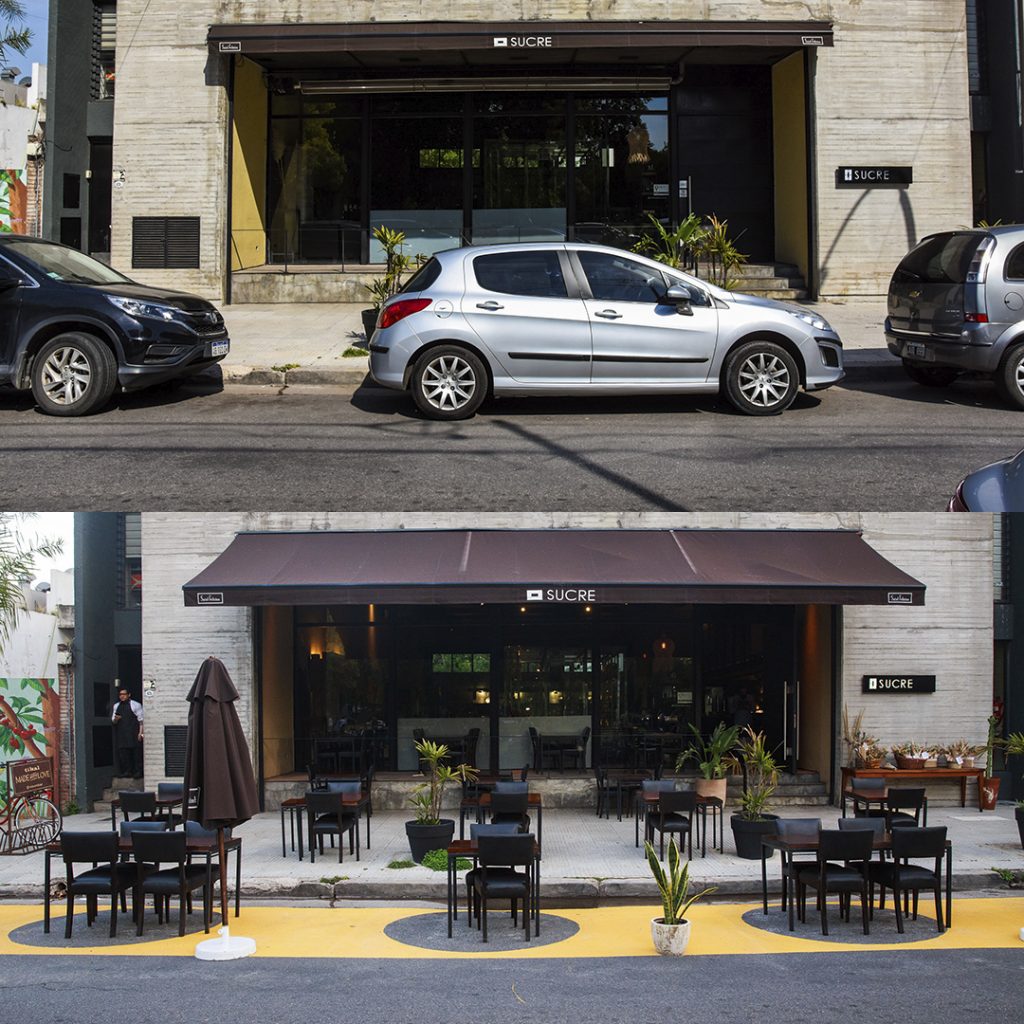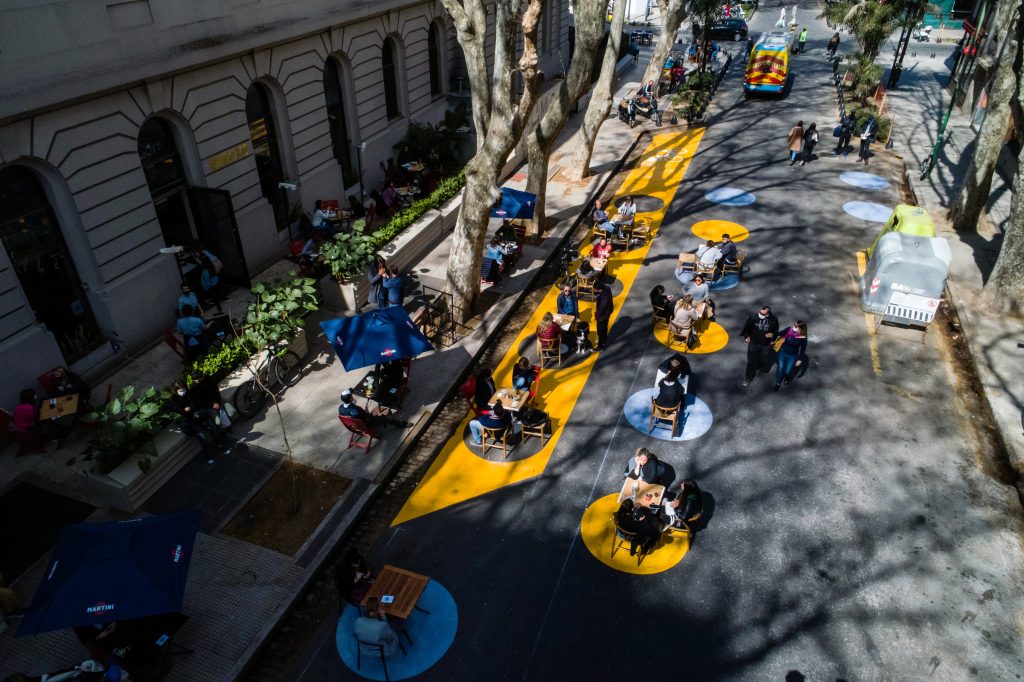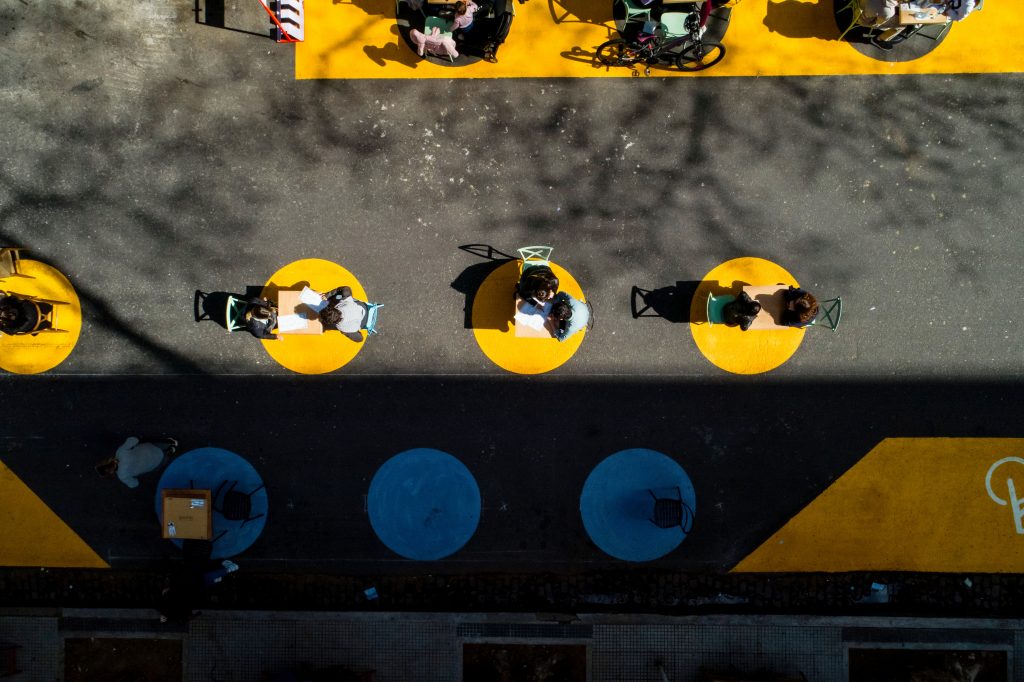Clara Muzzio is the minister of public space and urban hygiene in Buenos Aires and a firm believer in the transformative power of the public space and its relevance to urban life. She’s been involved in making Buenos Aires a greener and more inclusive city for more than ten years now, including leading the ambitious “Plan Microcentro”, which kicked off the city’s remarkable metamorphosis, making it more human-centred. We sat down with Clara to speak about authentic (female) leadership, her proudest moments, and how she envisions a liveable and accessible Buenos Aires for all.
Think about Buenos Aires – Argentina’s biggest city, a cosmopolitan capital with around 15 million inhabitants in its metro area: it’s home to Avenida Corrientes, one of the city’s major avenues that people refer to as “the street that never sleeps”, with the biggest concentration of theatres in the whole country. It’s like their own version of Times Square and the West End. There’s also Avenida 9 de Julio, the city’s major thoroughfare, an avenue that used to feature 20 traffic-filled car lanes. Not anymore – and one of the CityChangers responsible for that is Clara Muzzio.
Clara has dedicated her professional life to making Buenos Aires a more human-centred, green, and accessible city – for the people and with the people. How was she able to shape her city, and what did she take away from the multiple roles and perspectives on public spaces she has filled and experienced so far?
Renewing the City Centre – How to Deal with Poorly Maintained Sidewalks
Clara’s career within the city administration started back in 2008, when she joined the city as a Legal Advisor to the Commission for the Protection and Use of Public Space. Ever since, her work has evolved around aspects of public spaces. “Public space was love at first sight for me,” she says, “I deeply enjoy strolling and cycling through Buenos Aires”.
She soon changed departments and got involved in tasks that include the management of interdisciplinary professionals that were engaged with citizen involvement, giving citizens advice on public space usage, and participating in the design and implementation of policies aimed at the organisation of public space.
An exceptional milestone, both for her and the city, was the implementation of Plan Microcentro, which Clara had the pleasure of spearheading: a profound urban renewal project that kicked off back in 2011, involving pedestrianisation and transit re-orientation at the city’s financial, historical, and commercial district (including the aforementioned 20-lane avenue). You can read more about the ambitious project in our portrait of Buenos Aires.
Back then, Clara had known for quite a while that she wanted to change the focus in the distribution of street space. Plan Microcentro was an opportunity to make her vision a reality: “I had dreamt of this kind of change for a long time, and I had no doubt we needed to rethink the city, focusing on people instead of cars. I brought this vision to the then mayor, and, to my surprise, he was supportive and gave me the green light to move forward.”
“I remember that stage of my career with a lot of happiness and adrenaline. I was very young, and with my team of just ten people, we would go out into the city to survey the city centre’s 200 blocks to study how people experienced each of them and, based on that, design its transformation.”
After the success of Plan Microcentro, Clara was appointed as Undersecretary of Use of Public Space, with the main task of improving how the city’s public spaces were used and enjoyed. She implemented an innovative approach to managing public space and public works, coordinated urban renewal works, refurbished public markets, and improved both buildings and facades with heritage value as well as public spaces and street art.
In her following role as Undersecretary of Sidewalks and Pedestrian Ways, she spearheaded the improvement and renovation of half of the 320,000 sidewalks in the city, always considering how to incorporate plants, shrubs, and other green elements, and reducing maintenance costs while improving accessibility.
“It was an immense personal challenge. It was something different from what I had been doing, and meant building a whole undersecretary to focus on only one problem: the city’s sidewalks, which involves lots of different actors”, she says.
In retrospect, Clara’s very proud of what she has achieved together with her team: proud of the proximity, the engagement, and involvement they achieved with their constituency. “I am also proud of knowing we were working on and solving very relevant issues, listening to their [citizens’] stories, and realising how for many people, due to diverse reasons, this transformation meant they felt safer and freer to live their lives”, she adds.
In December 2019, Clara was appointed as Minister of Public Spaces and Urban Hygiene – the role she still fills today.
What sounds like an incredible career within the realm of public space surely didn’t come without its challenges and learnings: “I am very happy with my experience so far, every position I occupied gave me the opportunity to learn and the possibility of expanding an integral view of the city. And throughout all these years, there has been a lot of learning.”
Is there anything she would consider doing differently today, and what did she find specifically challenging as a CityChanger?
Authenticity Over Mimicry: How to Lead for Change
Clara found that what women do in leadership spaces, especially in these very male-dominated sectors, is highly relevant:
“As time passed by, I realised many times I mimicked men’s behaviours in negotiations because I thought that would lead to successful results. I now feel the responsibility, even if it is the longer road, to lead in a more authentic way.”
She continues: “Being a woman in a position of power, I know I not only have to manage my ministry efficiently and achieve impact, but I also have a responsibility in contributing to reshape our culture and contribute to bridging the gender gap, and that includes rethinking what leading successfully entails.”
Of course, that can be extremely challenging, especially when just starting out in your professional career. After finishing law school, her first job in policy was at the city’s legislature. Clara was originally looking forward to working on social issues, but that area was taken, and she was assigned the public space commission, which was something new and unknown for her.
“It was a “hard” area as it involves the whole urban hygiene agenda, space uses and monitoring and policing of different commercial activities, the infrastructure maintenance including streets, bridges, sewage, public lighting. It was a very male-dominated space,” she says, “but I realised it was also a platform to transform and improve citizen’s lives”.
This also applied to her following roles: “I had to sit at very difficult negotiating tables and interact with the administrators of service provider companies and manage to get results.”
During all of this, Clara raised two daughters. That also made her realise how valuable the transformations she was working on were, having to push her stroller through all these narrow and sometimes broken sidewalks. “I came to the conclusion that this is not specific infrastructure, but the development of consistent public policy for everyone in the city”, she says.
That is also how the Sidewalks Plan was born: to improve the walkability of the whole city. Clara is proud to have led this project, too. Looking back, all of the challenges she overcame and projects she implemented make her proud and happy:
“I am proud that I fought for a vision I believed in. It is very moving and thrilling to realise people value the change you bring to their street and to their life. On so many occasions, elderly people have approached me, telling me what a difference these transformations made in their ability to walk around the city without fear of tripping and falling, and how now they can enjoy walking again.”
So, what’s still to come after having achieved transformations like the Plan Microcentro and the sidewalk improvements? What vision drives Clara?
Visions for Buenos Aires: Putting Passion into Practice
Clara is convinced that walkability is the way to go for cities, no matter their size. “Walking has many aspects. There’s the transit aspect, but there is also a social aspect, through which we seek to improve people’s experience in relation to interaction and inclusion”, she says. Public spaces are people’s connection to the city. They aim to build a city that is the best city for everyone and that invites them to walk and enjoy public spaces, understanding it as part of the city’s culture and heritage, which includes green spaces and nature. If you create more and better public spaces, it will lead to more life in the city and promote equitable, healthy, and committed communities.
Meanwhile, she continues to enjoy walking through the city. “It is something I consider a must as a minister: I do it for work and for leisure, to know every corner, to understand more and identify what we can continue improving, to learn people’s stories, which are the inspiration of the best ideas.”
Asked for her grandest aspiration, she says: “My biggest wish is to build a city both my daughters and my parents can enjoy. And based on that, I project my vision for the rest of the people that live in Buenos Aires. Making sure the city is nicer but, most importantly, more human each day. And making sure that by the end of my term, I can say I made the most of the opportunity I’ve been given, leaving a mark on people’s quality of life.”






